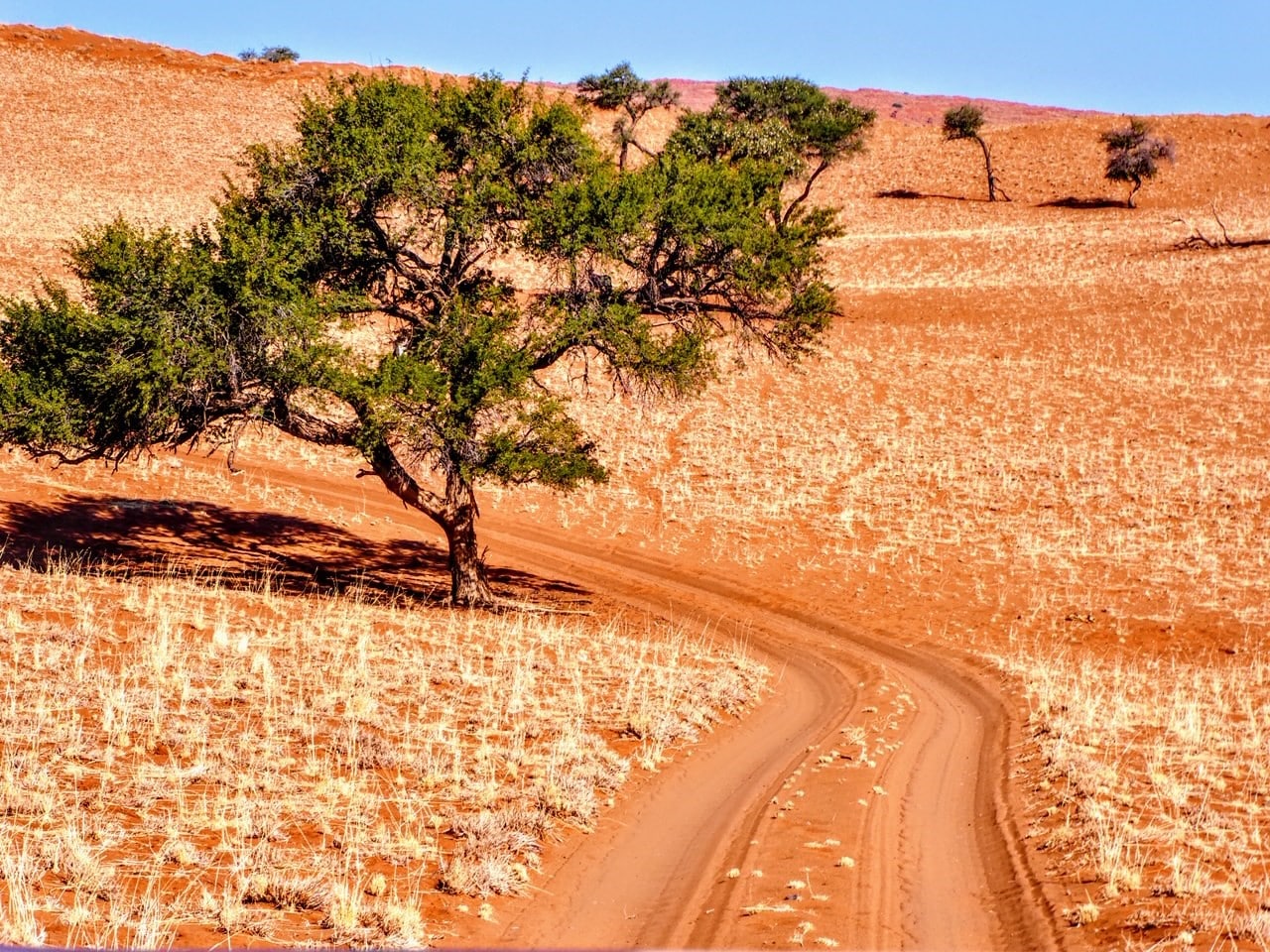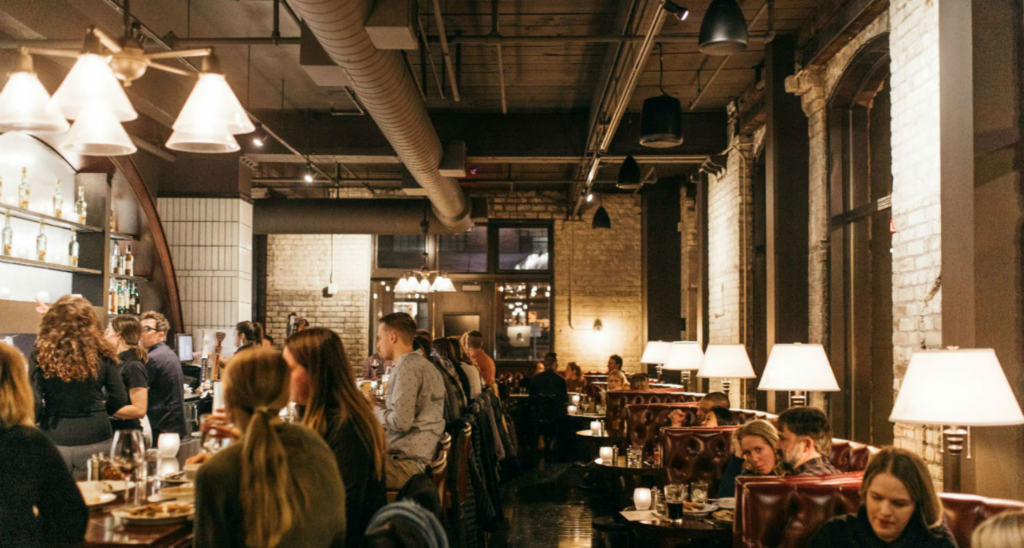April 1, 2019
Prologue
Our perceptions preparing for trip to Africa (that turned out to be all wrong):
- Yes, it will be hot, but we’ll need extra layers at night.
- The hotels will have Wifi.
- The trip will include seeing a few animals.
- We’ll be near the sand dunes that you see in pictures from Namibia. (Near. Not on, in, and up.)
- That’s what Namibia looks like.
- Victoria Falls will be the highlight of the trip.
- Namibia and Zimbabwe are similar.
Yes, we way over-packed without paying attention to the hot weather, the variety of locations and changes in landscape, and the game drives that showed amazing animals in action. In a way, we were glad we were naïve and ill-prepared (even though we know better). It made the trip more magical, surprising and a grand reveal at every new location. (It sure helps when you trust your trip outfitter…Backroads.)
Here’s an area-by-area recap of one of the most amazing trips of our life:
Namibia,Part 1: Namib Rand
No ice.
It’s our first sundowner in Namibia, and the setting couldn’t be more perfect. Perched on a small hill overlooking Namib Naukluft (the desert and the dunes), watching our first Namibian sundowner below the mountains. And it’s gin and tonic time.
But there’s no ice.
A G&T in 85 degrees without ice? The travesty.
Our Backroads guide, Dani, is never going to hear the end of this one.
Of course, we managed to muscle down the iceless G&T anyway. It’s tradition. (We redeemed it when we go back to the lodge, where ice was at the ready.)
We started in Windhoek, where we had a great hotel perched in the hills (The Olive Exclusive) that was blessedly close to Joe’s Beerhouse (a must-stop if you ever happen to end up in Windhoek).We then boarded a small Westair twin-engine prop Cessna bound for Namib Rand and the Wolwedans Dunes Lodge, set right in the middle of the desert and the dunes.
After 45 minutes, we began circling the endless orange hues until some white old tires were spotted. Apparently, that was our landing strip.
A dune ride out to the lodge brought us to the most vast middle-of-nowhere location we’ve ever seen. We were greeted by oryx wandering everywhere, and even spotted our first chameleon.
The desert is hot and dry, and after five minutes, the orange sand is everywhere. You have to give up and surrender to it, drinking endless bottles of water to maintain your slight advantage over the power of the heat. The colors of the desert, the dunes, and the mountains are constantly changing, and you can make out different textures and layers to the landscape every time you look.
We spent an incredible two days in an open tent, with a surprisingly refreshing breeze coming through our screens. During the heat of the day, you can’t imagine being as cool as you are at night. We did a dune hike and a desert walk, learning about the snakes, spiders, lizards, oryx, zebra, giraffe, and the native San bushmen’s survival skills. We had dinners by candlelight and walked back to our tent by way of solar-powered Mason jars (they collect sunlight during the day to light the pathways at night).
“Otherworldly” is likely the only word to describe it. It was either the end of the earth or the middle of nowhere. But, yes, thankfully, they still had wine. (I know you were worried about us for a second.)
Namibia, Part 2: Wolwedans
It starts to sink in that you’re in Africa when you’re in your (admittedly very fancy) tent, on top of an actual sand dune, with an oryx laying under your deck. Pun intended. (Sink in, sand dune… Get it?)
Wolwedans is set on 700,000 hectares of dunes, plains, and mountains called Namib Rand, which backs up to Sossusvlei—which makes up the rest of the Namib Naukluft desert and dunes. It’s unimaginably massive. It makes 700,000 acres feel like a micro-apartment. It makes you feel like an ant.
It’s the second-driest desert and the one of the largest in the world, and we were staying right on the dunes (essentially, in a giant pile of sand—as evidenced by our luggage, feet, clothes, ears, and eyes).
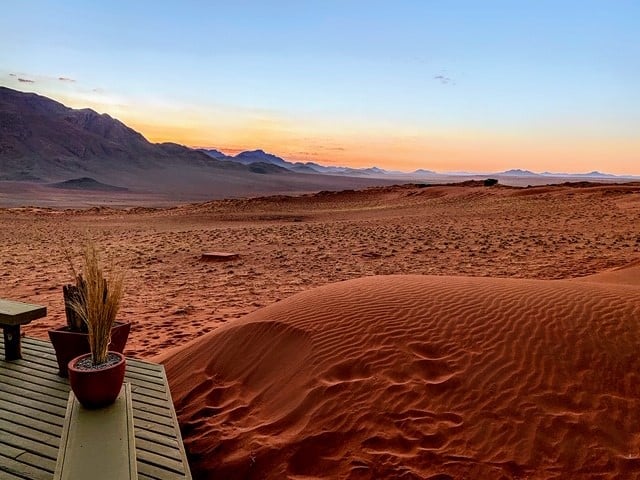
Our first day and a half at Wolwedans was spent getting to know the people there and taking in the sheer vastness of the land. It’s one of those places where you truly believe that if you were left alone, even for a few minutes, you likely wouldn’t make it 100 feet—and certainly not in the right direction, because of that damn Southern Hemisphere thing. It’s immense. The word “remote” doesn’t seem powerful enough. The properties are 100% sustainable, with their own greenhouses, wells, and animals. They’re taught to respect the land, bringing a new reality to us stupid Americans.
The people there spoke fluent English, but were from tribes all over Namibia with their own languages. They were all younger, either with training in hospitality or time spent as guides showing off their country. And they were all incredible, working incredibly hard and teaching us in a short time the importance of the little things in this very big land.
Felicity was like a tiny Beyoncé, with her singing and moves. Frankie dreamed of going to the US, namely Vegas—although we really tried to talk him out of it (Vegas must have a fantastic marketing campaign in Namibia; imagine the disappointment to discover just another desert). Frankie also loved to laugh at people stuck in the soft dunes, which happens constantly. (And we thought we’d escaped the plows back home—here, they have to clear the sandy “road” daily.)
The San Bushmen (I nicknamed them J&B, because their names included a series of clicks—hard-to-pronounce African consonants) taught us how to spot and track beasts of all sizes by keeping a sharp eye out for the details—the ones we westerners usually stomp over in our haste to get to the next place.
The second sundowner redeemed the first because, well, there was ice. (Frankie dragged it there for us.) He drove the Rover like a dune buggy, with our batshit-crazy Backroads guides (Dani and Russell) climbing out to sit on the top luggage rack with their stabilizer. All at 30 kmh, of course. It was like being led by excited 12-year-olds, in the best way.
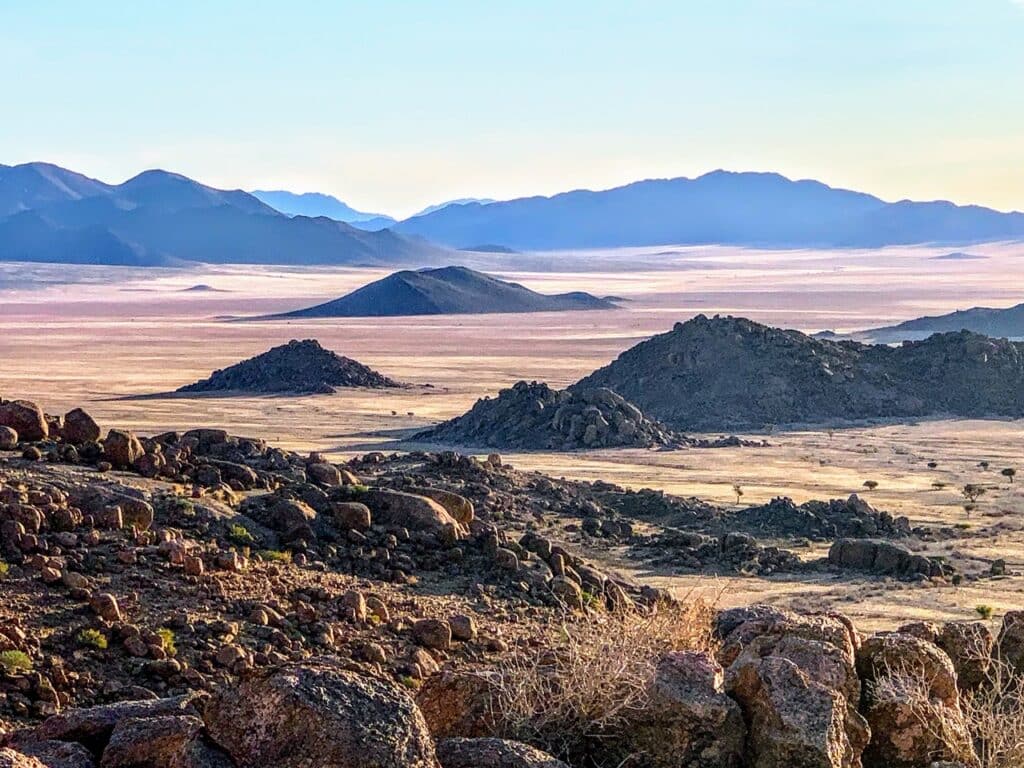
Then we arrived at the golden plains and mountains, an area incredibly different from the desert dunes. We hiked through a kloof in the hills to a long-abandoned farm, where we took in the sunset with a proper G&T.
As much as we learned to appreciate the little things, ice is still the ultimate luxury in Africa. And this most certainly was Africa.
Back at the lodge after dinner, the Milky Way and the Southern Cross competed with the nearly full moon in their brightness as we walked back to our screened-in tent.
I guess we’re in Africa.
Namibia, Part 3: Hiking Big Daddy and the Sand Dunes
I mentioned we were sleeping on the actual sand dunes, and this morning we’re climbing the dunes. (As in, more than the climb from our tent room to the lodge.)
We were going to meet Big Daddy.
Sossusvlei in Namib Naukluft National Park is one of Namibia’s most popular attractions. It’s a small slice of the Namib Desert with access to hike the vast orange sand dunes. We’d seen pictures, but we had no idea.
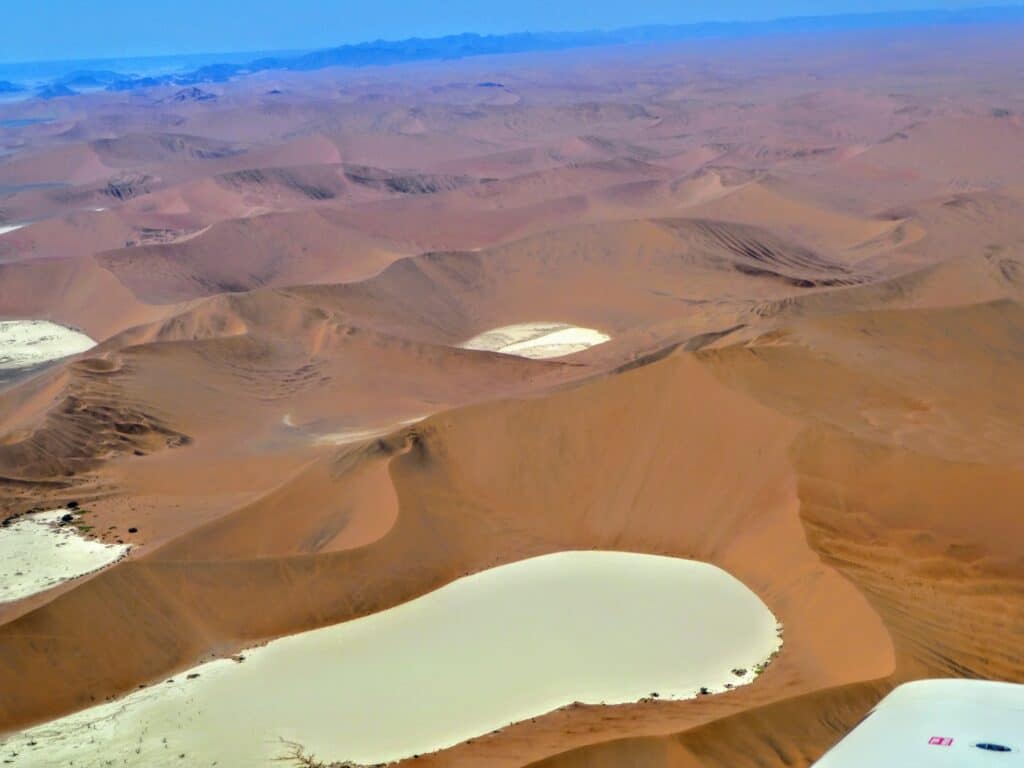
We were the first ones in the park, which is comprised of about 30 kilometers of dune after dune, each one numbered. Number 45, for instance, is popular because it’s a close walk from the parking, and it’s one of the easier dunes to climb (AKA: meant for the lazier tourists). We, of course, headed to the very end of the park to tackle Big Daddy, by far the highest. On the way, we had to drive through all the sand—which Frankie, loved, laughing at all the tourists who got stuck and couldn’t drive through.
We’ve walked on beaches before. It’s a bit harder than normal ground, but how bad can it be? It’s all sand, right? Well, answer that question once you’ve scaled more than 300 meters of dune.
It. Was. Hard. I’m talking panting, sweating, I-think-my-calves-are-going-to-seize-up hard.
Big Daddy is the most famous of the dunes because it’s set directly over what’s called the Dead Vlei, a massive dry white-limestone deposit formation that looks akin to a white lake at the base of the dune, with a few sparse trees. Most normal people park in the lot, look up, and take pictures of Big Daddy, then leave. Us? We had to climb it.
Why?
First, it’s the highest. And as well all know, always go to the top. Second reason? Well, to blast down nearly 1000 feet of sand dune, of course. I guess the eventual payoff (views of the massive sand dunes in every direction as far as the eye could see) wasn’t bad, either.
Our group of six was one of the first on the dune in the morning, just after sunrise. That’s an important point, because the mercury rises to nearly 100 degrees Fahrenheit by midday.
The first section didn’t seem so bad. It was all an incline, but seemed manageable. We needed some hard-core exercise because of all the eating and drinking we’d been doing on the dunes.
Then there was a small push to the major ridge line, which was like trying to walk uphill through quick sand. We got up to the first ridge line, which felt like a real accomplishment.
Then we looked up. We hadn’t made a dent.
We were literally walking on the top edge of a giant sand dune. It’s a bit surreal when you look at the ground so far away and realize there’s no going back. There’s no going anywhere. The whole climb took a little over an hour, although it felt three times longer.
But the views.
With every step, at every angle, it was unimaginable. The vastness, the remoteness, the beauty. When you get to the top, there are dunes as far as you can see.
The way down? An almost sheer 1000-foot drop of walking/dancing/running down the dune to reach the cracked white limestone. It’s a bit like bungee jumping or skydiving. Just swallow and go. Bend your knees, lean back and bit and…
Enjoy. It was one of the most incredible experiences.
You get to the expanse of white at the bottom and turn to see the other crazies kamikaze’ing down the hill as you pour about a pound of sand out of each shoe.
Surreal. Worth it. Why wait for someday?
We’re now off to our Cessna to go to the mountains, with a fly-by of thousands and thousands of acres of sand dunes all the way to the sea.
And our pride in climbing the highest of them all.
Namibia, Part 4: Mowani Mountain Lodge in Twyfelfontein
If you aren’t familiar with Backroads, one of our go-to travel outfitters worldwide, here’s a short description of the guides: You know those people who inspire Mountain Dew and Red Bull ads? The ones who are always diving off cliffs, rappelling down rocks, jumping off moving vehicles, etc.? Those are the Backroads guides. They’re multi-lingual, smart, well-traveled, excited, and completely nuts.
Dani, our Catalan-born guide, was no exception to the rule. He spent tons of time researching and traveling this beautiful country to create the perfectly curated trip for us, and his excitement was akin to a kid showing his parents he aced the test—and he always gave us a sneak peek ahead to get us excited about the next part of the adventure.
After emptying the rest of the sand dune from our shoes and taking a wet-wipe bath, the Cessna awaited, and Dani was describing Damaraland, AKA “the mountains.” In superlative-laden language, he was setting the stage for us to leave the dramatic dunes, destined for the painted-rock cliffs and petroglyphs in Twyfelfontein.
David summed it up more succinctly: We were leaving giant piles of sand for giant piles of rocks.
Did I mention the guides put up with a lot of our shit?
Our flyby of Big Daddy, the Desert Dunes, and the Skeleton Coast illustrated we were leaving the edge of the earth. (We were, in fact, headed from one middle of nowhere to another.) The way the vast desert and dunes dramatically returned to the ocean coastline made it look like the world actually stopped right there.
This is starting to sound bad romance novel. Or, at least a Bromance novel with Backroads (not a bad title, by the way).
After flying up and over the mountains, we came to another Cessna stop on the extremely short gravel runway. We were surrounded by multi-colored sandstone cliffs, rock formations, and a dry riverbed lined with green trees that snaked through the mountains and plains in between. Water was even more scarce here, and the sandstone rocks everywhere left very little room for green.
Who in the hell found this, and how and why did they stay? There was nothing that looked habitable. No water, no green except for the lines of trees, and no apparent natural resources. Just Rosie from Mowani, waiting for us with a Jeep and a big smile.
Lastly, how did they pick this particular series of rock piles as the site to build a lodge?
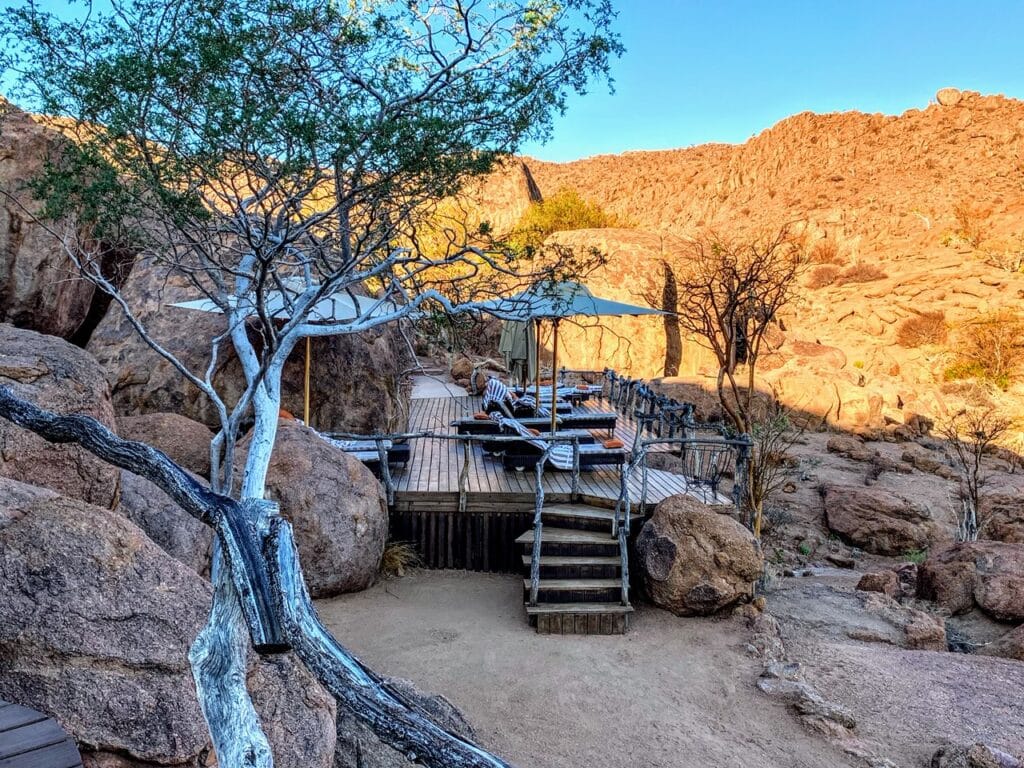
Mowani Mountain Camp is a series of treehouses literally built into rocks. It was impossible to imagine how they got the resources to the actual middle of nowhere to build an all-open-air hotel with thatched roofs and views of the mountains and plains in every direction.
We had a big plans for the rest of the day. The major task at hand was to head to the rock-top viewpoint to celebrate the sunset in one direction and the moonrise in the other. With G&Ts, of course. Our daily ritual became watching the sun rise and moonset every morning and finishing the day watching the opposite, with the only difference being the gin (evenings only).
Perfection on repeat. Back to the bad romance novel.
But wait for it: The trip was timed perfectly for the full moon, an excess of perfection even for Backroads.
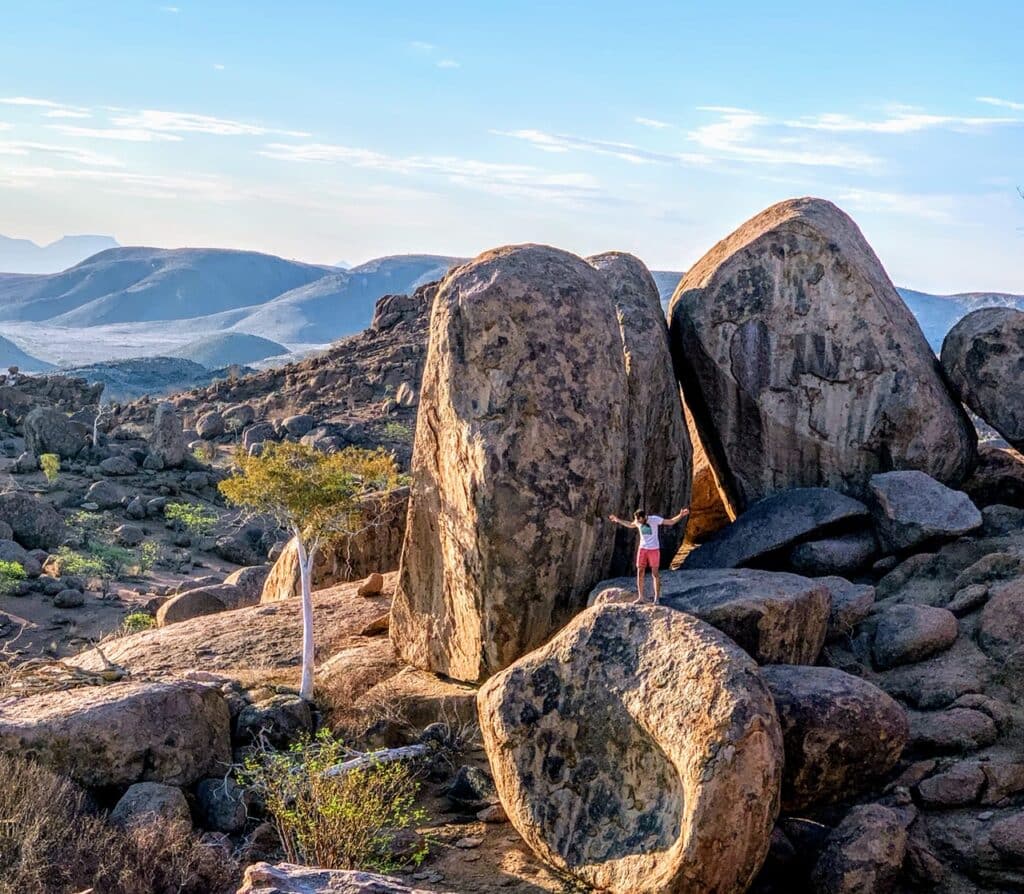
The answer to how and why we were here came the next day. Twyfelfontein is a discovery of petroglyphs (rock engravings) dating back thousands of years, which can be found as you climb up through the rocks. The engravings document many human and animal evolutions, and show how the Bushmen and Damara tribes taught their kids and kept track of water holes. It’s now been named a Unesco World Heritage site to try to preserve the incredible works of remedial art that you’d only want to discover here, not in some museum.
Sundowners today was scheduled to be with the elephants, only they forgot to call ahead and tell us where to meet them. Dani was ticked off; he’d confirmed the date and time twice. Elephants can be so flaky.
We drove along the dry riverbed to find them, and they finally waved us over. They surrounded our Jeep, looking to replenish their gin supply and see if Rosie brought the chocolate muffins this time. Some of their babies got tired and laid in the dirt while Mom and Dad scored snacks and drinks. And Rosie had plenty of ice on hand, because, like me, elephants hate iceless G&Ts.
After about an hour, they decided they’d had enough and poetically strolled off into the sunset. I guess this made up for them not calling ahead.
Back at the Lodge, Rosie (at the request of Backroads) brought in a few friends from the Damara tribe to show how they make fire from dried elephant dung, sand, and wood sticks. Apparently, the men are not worthy of a mate until they can make fire from absolutely nothing. (Imagine that qualification on dating app. There would not be a lot of mating going on.)
Rosie herself was a highlight. She was part of the Damara tribe, and started cleaning rooms at a lodge before working her way up to becoming the first female black guide in Namibia. In Namibia, that’s the equivalent to making fire out of nothing.
After a walkthrough of the Twyfelfontein World Heritage site the next morning, Rosie delivered us back to our trusty Cessna and Björn, our pilot.
Every time we saw Björn (the only person in Namibia who wore a white shirt and a tie) in the mornings, it was like he was rescuing us from a deserted island, with an unknown adventure waiting.
We took off with a smiling Rosie waving to us from the middle of nowhere below.
Namibia, Part 5: Onguma Fort and Etosha Salt Pan and Etosha National Park
It was hard to miss the Etosha salt pan flying in. It’s like someone peeled off a piece of the white moonscape as if it were an orange, and the giant peel landed in the middle of Namibia.
At every landing, we had a welcoming committee. At Wolwedans and the Sand Dunes, it was the oryx. At Twyfelfontein, it was the ostriches. At Etosha, it was just a few impala. I guess the giraffes were double-booked that day.
Onguma the Fort, our next hotel, had an expansive deck overlooking a big watering hole, which backed up to Etosha National Park. In case you missed it earlier, there’s not a lot of water in Namibia, so a watering hole is an actual, literal oasis. The hotel was designed in the style of a Moorish fort for some reason, transplanting a bit of Moroccan and Indian style to the salt flats.
Onguma had kindly cued up the wildebeest, warthogs, jackals, and a few other random varieties of wildlife to be perfectly placed right in front of our rooms to say hello. How thoughtful.
And now it was time to start the game drives. Game drives in Africa all have a similar type of routine which, by description, can sound a little boring. Get in open-air Land Rover, drive through the bush, look for animals, watch animals, have sundowners (the ritual of cocktails and snacks over sunset), repeat.
In reality, it’s not boring at all. Let’s play out a few typical scenarios:
A mother and her baby rhino are wading and drinking at the watering hole when a few wildebeest get within sight lines and begin nudging toward the water.
Rhino to Wildebeest: Really? You again? Boy, you are as dumb as you are ugly. You don’t remember what I can do with this the giant horn?
About 12 giraffes are gathered at the watering hole.
Giraffes to each other and us: Great, here come the idiot tourists again. Can’t they at least wait until after happy hour?
Why is me drinking water photoworthy? You think it’s fun to have to bend down this far with bad knees?
Yes, I have eyelashes. I don’t comment on your eyelashes, do I?
No, we haven’t seen the elephants today. Try Charlie’s bar down the road.
The warthogs are the first to approach the water.
Warthogs to each other: Have you ever thought about getting that thing removed?
Oh, great, and here come the damn wildebeest. And people call us ugly. It looks like they were made with a bunch of random parts from other animals.
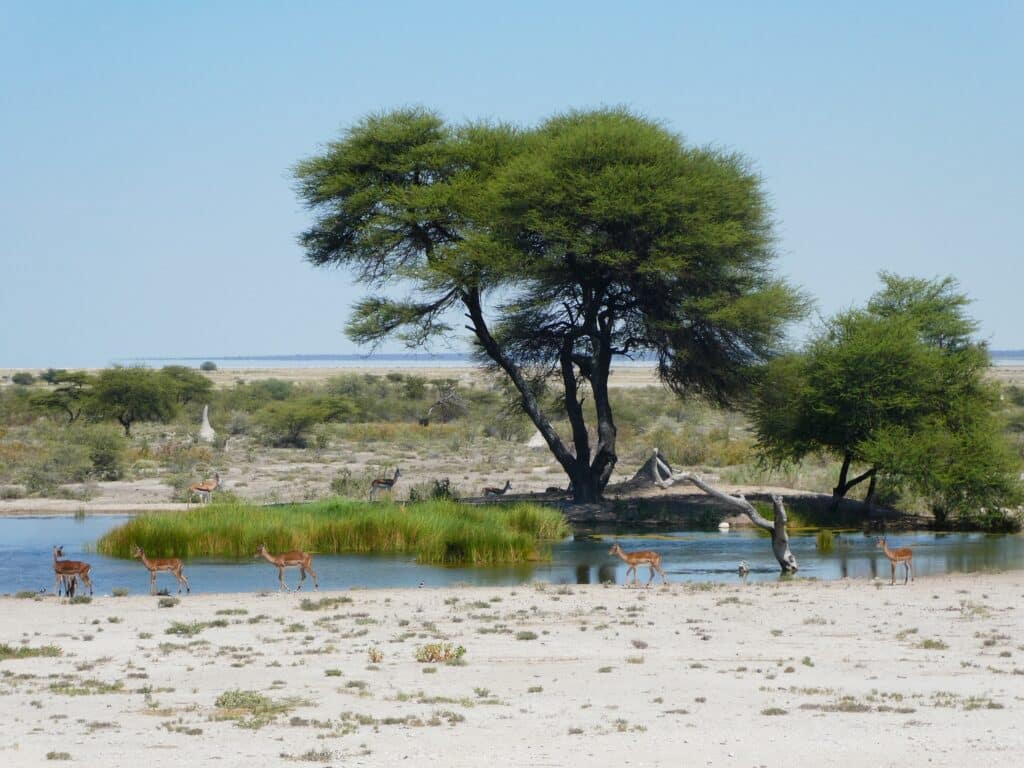
The mother lode is gathered…
It must be Friday night. Jackals, elephants, impala, guinea fowl, wildebeest, warthogs, oryx, a couple of random boks (springboks and other various boks), giraffes, and the hyenas start to approach.
Everyone immediately settles into their stereotypes and cliques, like the mean girls in high school:
The wildebeest are the dumb ones, who fall for anything and are spooked by everything.
The boks and impalas are the cheerleaders, constantly happy and jumping around. Not sure who they’re cheering for.
The elephants are the cool football players. Defensive lineman, not the Tom Brady pretty-boy quarterbacks.
The hyenas are the bullies.
The warthogs never outgrew their awkward ugly preteens, so they stay in a group off to the side.
The rhinos are standoffish, and never, ever, ever consort with others. And the others seem to be just fine with that. Back to that horn thing again. (Which, unfortunately, make them highly poached.)
The hippos are usually off in a dark room. Likely smoking dope.
The lions? Well, it’s good to be the king.
The look on the cheetah’s face says what we all know to be true: “If we’re in the mood, we will eat you. If we’re not, we’ll just manipulate you.” Probably voted biggest brownnoser before they attacked the teacher. (No matter the size of cat, from house cat to leopard to lion, it’s always the same.)
The jackals? They’re the 12-year-old pranksters who never grew up (kind of like our Backroads guides). They have endless energy and are always running around, wanting to play and climb and explore.
See, not boring at all.
After narrating the days of the animals’ lives as they all call a truce at the watering hole (a desert soap opera for the ages), we came back to Onguma to watch the thunderstorms and lightning on one side of the broad, sweeping flats of the savannah, and the sunset that lights up the sky in technicolor in the other.
And back on the deck, we hear the lion roar from about 400 meters away.
Work, work, work.
Zimbabwe and the Big Falls
It was almost a disappointment to fly into Victoria Falls.
The flight with Björn was smooth as always, but it concluded in an actual airport, with a runway you could see from the sky instead of gravel with a few white tires to mark a landing area. Where was the sport in that? Also, actual people were our welcoming committee here.
No offense, guys, but ostriches are a lot more fun.

Flying in, we could see Victoria Falls in the distance. It’s one of the three biggest waterfalls in the world, but from the sky, it looks like a small gash in the earth with mist rising above.
We ended our trip in Zimbabwe, giving us the experience of another African country. Thankfully, the Backroads crew had opted for a lodge about 45 minutes outside was looked to be a pretty touristy little town—so we could actually meet the people and try to better understand the real Africa, rather than just looking at the falls and leaving (the usual visitor agenda).
Our home for the next several days was on the banks on the Zambezi River, which merges downstream to create Victoria Falls. Matetsi Lodge is one of those African lodge experiences you have to make sure to have at least once in your life.
This kind of experience, especially at Matetsi, is truly special. There is a team of people who become your extended family. They make you feel completely, immediately comfortable. The main lodge area is an open-air gathering spot on the expansive river, with food, drinks, games, books, lounge chairs, and whatever you need to make yourself at home while you’re there. The rooms are all individual buildings, with their own indoor and outdoor spaces (that you wish you could replicate for a summer cabin).
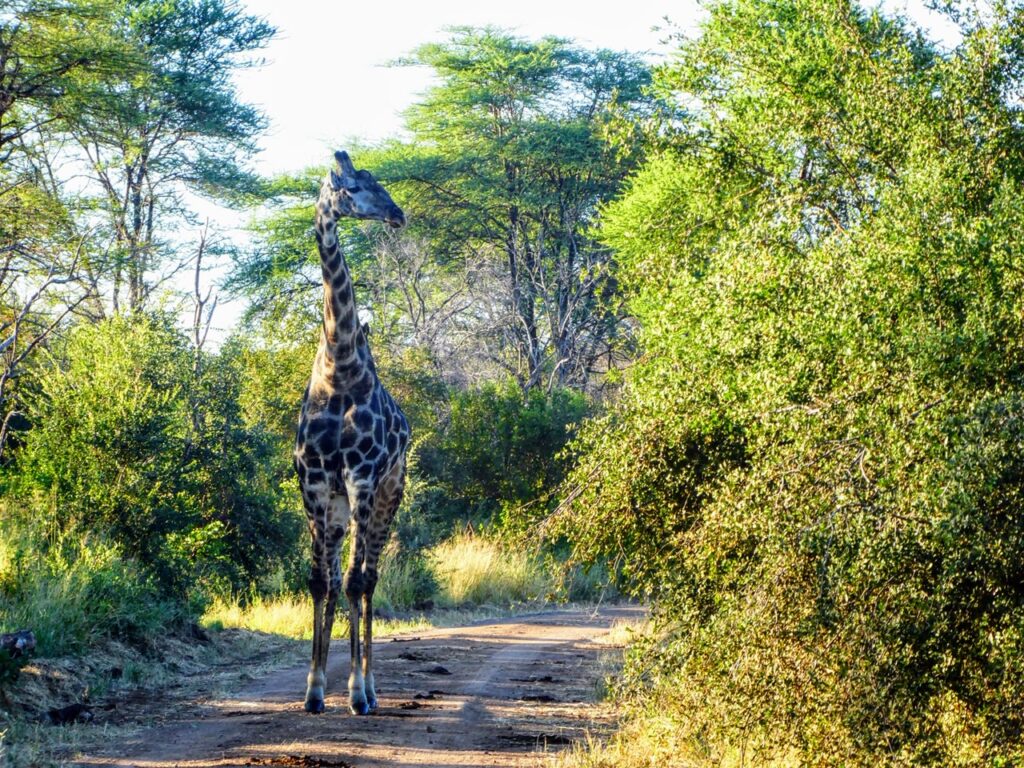
Ophious (and Bongani) were our trackers and guides, and Ophi had a great deadpan sense of humor (our favorite kind). He introduced us to the local baboon troops, the cape buffalo, giraffes and elephants that preferred walking in front of us on the road at their own speed, and the various impala and boks—we’re assuming they’re cousins of our friends earlier in the week. The hippos lived in the river in front of us, and the crocodiles liked to make an appearance when you least expected it. The baboons also loved to come up to our patio doors to check us out. One jokester particularly loved mooning us with his red ass.
With game drives, breakfast in the bush, and lounging in chairs by the river, the days flew by. Matetsi is truly special, owned by a family from Zimbabwe really investing back in their own country.
We also learned the realities of the country of Zimbabwe. First, we were there on the tail end of a cyclone that had devastated Mozambique and parts of Zimbabwe, leaving thousands dead. The team at Matetsi was starting to mount relief efforts.
Zimbabwe has also been victim to significant political turmoil (this may be the biggest understatement I’ve written). A recent election had results that could make things better or worse—they haven’t decided yet. There’s a nearly 90% unemployment rate in the country, a shortage of cash, and although Victoria Falls is a major attraction, it’s not enough to drive the entire country.
When we arrived, we asked our driver if they had ATMs there. Oh, yes, he said, with pride. After about 30 seconds, he added, “But, of course, they don’t have any cash.”
It was so good for us to see the reality of the country, rather than the tourist postcard. The people, as they were in Namibia, are beautiful, warm, and hardworking. You immediately want to do something to help, and the options to do so are endless. It’s a beautiful part of the world.
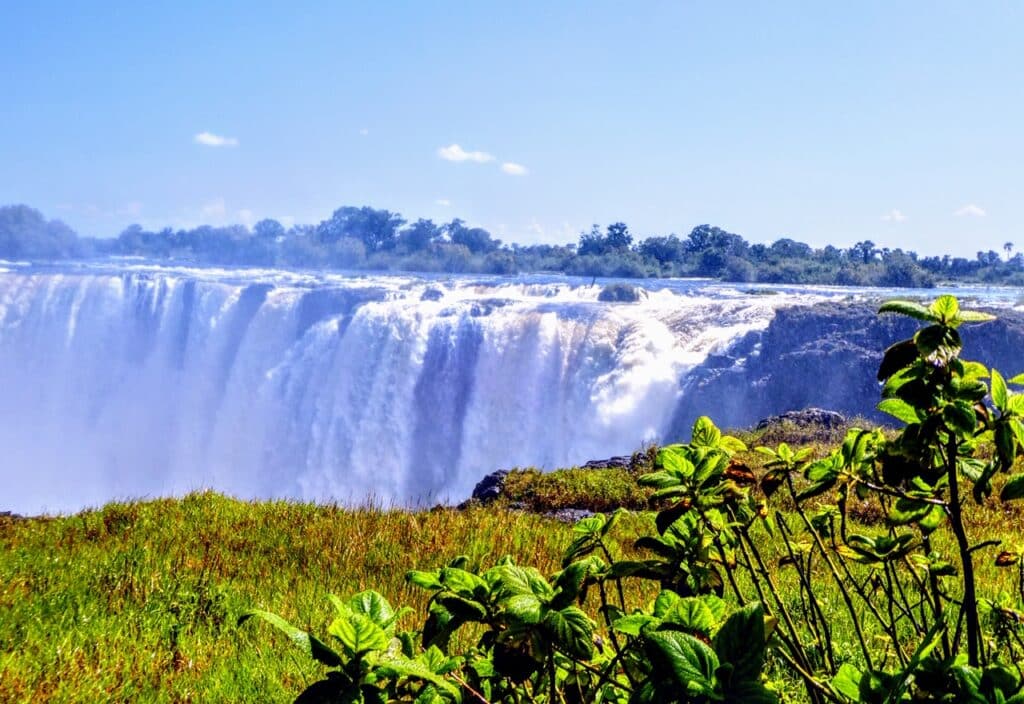
We ended our trip to Africa with a trip to Victoria Falls. The Big Falls are a bit hard to understand or document. It’s literally two rivers going along, minding their own business, when they reach the small gash I described from the air and drop more than 100 meters into a gorge below. It’s like if you’re walking along flat ground and accidentally step off a cliff.
The force of the waterfalls is powerful. When you walk the 1.5-kilometer path with various viewpoints, it’s like walking in the rain, even when it’s 85 degrees and sunny. We were drenched.
We’re lucky to have had a chance to see it, but even luckier in that we got to know many people from Zimbabwe first, instead of doing the typical tourist drive-by of one of the natural wonders of the world.
Goodbye to Africa, for now. We will be back.
Epilogue
What we loved:
Sand dunes, Big Daddy, oryx (especially under our deck), sunrise, sunset, moonrise, sundowners (and with elephants), Etosha, Matetsi Lodge, big skies with lots of stars, brightest Milky Way, Southern Cross, elephants walking into the sunset, no screens, and open air.
What we learned:
Vast, remote, beautiful people, variety of landscapes, hot, dry, sandy, rocky, colorful, diverse, variety of tribes and languages.
What we would have changed:
How we packed.


